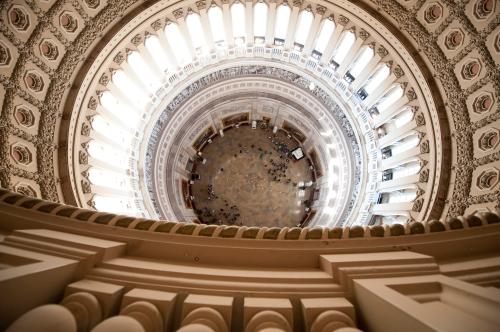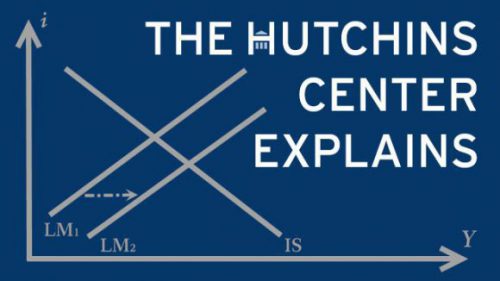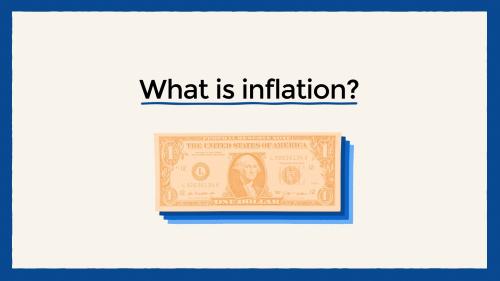Since the Federal Reserve’s policy-making Federal Open Market Committee (FOMC) raised interest rates by ¼ percentage point on Dec. 14, several FOMC members have discussed whether and how they are factoring the prospect of major fiscal stimulus into their economic outlook and expectations for interest-rate increases in 2017. Fed Governor Lael Brainard will give her take on this topic on January 17 at the Hutchins Center on Fiscal and Monetary Policy, the first Fed governor to speak at length on the issue since Fed Chair Janet Yellen’s Dec. 14 press conference. Below are gleanings from speeches and interviews by Fed policymakers, listed below in alphabetical order.
James Bullard, President of the Federal Reserve Bank of St. Louis
“We think there is some upside risk because the new administration wants faster growth and it is possible some of the things they are talking about will drive productivity higher. But we don’t think that would be likely to occur in 2017. It would probably be 2018 or 2019. That will give us time as monetary policy makers to assess what is being done and make a judgment as we go forward.” (Bloomberg)
Charles Evans, President of the Federal Reserve Bank of Chicago
Evans said rising bond yields in the wake of the November elections caused him to modestly increase his growth outlook, but in addition to that he hasn’t altered his outlook much to reflect potential fiscal stimulus and doesn’t expect to do until after seeing detailed plans from Washington. As for the economic effect of the Trump administration’s trade policies, Evans said he is “still trying to learn about what they’re going to be discussing, negotiating, and all of that… at the moment… you can’t begin to… factor that in.” (Wall Street Journal)
Patrick Harker, President of the Federal Reserve Bank of Philadelphia
Even before factoring the impact on the economy of any fiscal stimulus, Harker expects three interest-rate increases this year. “I’ve not factored in any changes in [fiscal] policies yet because I don’t know what they are,’ he said, adding that he would need to see a “pretty solid bill that has support of Congress and the president” before doing so. (Wall Street Journal) “As the policy uncertainty resolves itself, we’ll be able to see whether it’s 3, 2, 4 [rate increases in 2017],” he said. (Sirius, Bloomberg Markets)
Robert Kaplan, President of the Federal Reserve Bank of Dallas
Kaplan has pointed to several of President-elect Donald Trump’s plans as likely to boost productivity and growth, but said he would be “scrutinizing” Trump’s policies on immigration, trade and repealing the Affordable Care Act. The regulatory, tax reform and infrastructure investment that Trump has promised could benefit the U.S. economy, he said. Asked about Trump’s plan to build a wall on the U.S.-Mexico border, Kaplan noted that immigration and trade have historically boosted U.S. growth. (Reuters) Kaplan also said that possible fiscal policy actions and other developments in Washington impart an upside risk to his outlook, if anything. (Wall Street Journal)
Jeffrey Lacker, President of the Federal Reserve Bank of Richmond
“A prudent course for a forecaster to take right now, I believe, is to build in at least some modest fiscal stimulus and at least some measure of stronger business investment. Such an approach would split the difference between complete faith in market ebullience and an assumption of no change in the fiscal and investment outlook. For me, this suggests a forecast for real GDP growth of 2.0 percent for 2017, falling to a long-run trend of around 1 ¾ percent in 2018 and beyond.”
“While there is currently tremendous uncertainty around the shape and size of any federal policy initiatives, the direction of the effect on monetary policy seems pretty clear… all other things equal, greater fiscal stimulus implies higher interest rates than would otherwise be warranted. Otherwise, inflation pressures are likely to become elevated, as we saw in response to expanded fiscal deficits in the late 1960s.”
“While a more stimulative fiscal policy outlook may have contributed to the uptick [in project interest rates in FOMC participants latest forcecast]…several other factors could well have been relevant. For one, improvement in measures of inflation compensation were underway well before the election, and realized inflation has come in a bit firmer than many analysts had projected earlier in the year. In addition, while real GDP growth was depressed early in 2016 by temporary factors that were expected to fade, confirmation did not emerge until the arrival of third-quarter data. And finally, employment growth has not decelerated in 2016 as much as some forecasters had projected.” (Prepared remarks)
Dennis Lockhart, President of the Federal Reserve Bank of Atlanta
“Many in the business and financial community are anticipating improved growth prospects with the change of administration in Washington. Again speaking only for myself, I have not factored fiscal stimulus and regulatory change into my growth forecast. Without details, I consider it too early to estimate the effect of these policy changes.” (Prepared remarks) He also has said that he views fiscal stimulus as “an upside risk factor” that could justify three one-quarter percentage point rate increases in 2017 even though he had forecast only two moves. (Bloomberg)
Loretta Mester, President of the Federal Reserve Bank of Cleveland
“I incorporated a bit more fiscal stimulus into my forecast. Obviously, there is uncertainty about what those policies will be… But I do think that the likelihood of there being some kind of stimulus has risen, and so I incorporated a bit of it into my forecast.”
“I think we’re basically at full employment in terms of what monetary policy can do, and I think that inflation is going to be moving back up to 2 percent over the next couple of years. So I don’t see a need of the kind of fiscal policy just to stimulate aggregate demand…”
“My view is that there are upside and downside risks. Even in the nature of the fiscal packages, there are a bunch of scenarios you could run… We’ve got to be very cognizant of the fact that, you know, we have to wait until we see what the packages look like, wait and react as we get more information. So it’s going to be an interesting year.” (Wall Street Journal interview)
Jerome Powell, member, Federal Reserve Board of Governors
“We may be moving more to a more balanced policy with what sounds like more business-friendly regulation and possibly more fiscal support….Monetary policy [might be] able to hand it off and I think that’s a healthier thing. We may be moving to a more balanced policy mix.” (Reuters)
Eric Rosengren, President of the Federal Reserve Bank of Boston
The increase in long-term interest rates in the U.S. and around the world since November “may reflect the expectation of potentially more stimulative fiscal policy, greater confidence that inflation will increase toward targets, and more optimism about global prospects” (Prepared remarks) Rosengren also has indicated that would help determine the timing of rate increases this year is more clarity on fiscal policy and additional data on the international landscape particularly China. “There are a lot of uncertainties—and one is exactly what is the fiscal package we will receive,” he said. (Wall Street Journal)
John Williams, President of the Federal Reserve Bank of San Francisco
“I don’t have any particular insights into what the new Congress or the new administration is going to do around fiscal policy… I do think, even though I’m definitely ‘wait and see’ in terms of learning what happens, the main effect on my outlook is that my view on the risks to the outlook have shifted a little. Those risks used to be maybe balanced and if anything a little bit to the soft side because of global developments and other factors that might cause growth to weaken. And I think that the possibility of greater fiscal stimulus and other changes in policies would if anything move those risks a little bit to the right. But it’s not a big effect.” (NY Times)
“If you were to ask me three years ago, four years ago, when unemployment was still high and the economy was still digging out of a hole, I would have said, sure, fiscal policy would be great… But today I don’t think we need short-term fiscal stimulus. What we need is really better policies and investments in the long-term health of the economy.” Williams added that discussions with businesses in his region find optimism about the potential impact of tax cuts and deregulation, but concern among exporters about the prospects for trade barriers and restrictions on immigration at a time when available skilled labor was hard to come by. (Financial Times)
Janet Yellen, Chair of the Board of Governors of the Federal Reserve System
“As many observers have noted, changes in fiscal policy or other economic policies could potentially affect the economic outlook. Of course, it is far too early to know how these policies will unfold… Some of the participants, but not all of the participants, did incorporate some assumption of a change in fiscal policy into their projections. And that may have been a factor that was one of several that occasioned these shifts, but I want to emphasize that these—the shifts that you see here are really very tiny…”
“I would say at this point that fiscal policy is not obviously needed to provide stimulus… I’ve continued to highlight the importance of spurring productivity growth, that I think that would be something that’s beneficial for the economy. Of course, it’s also important for Congress to take account of the fact that, as our population ages, that the debt-to-GDP ratio is projected to rise, and that needs to continue to be taken into account.”
“We’re operating under a cloud of uncertainty at the moment, and we have time to wait to see what changes occur and to factor those into our decision-making as we gain greater clarity… I see the market moves as implicit forecasts about what impact these policies are likely to have on the economy… financial market changes… particularly the increase in stock prices, the increase in longer-term rates, and the strengthening of the dollar, suggest that many market participants anticipate expansionary fiscal policies that would raise interest rates somewhat in the United States relative to abroad and would cause a strengthening in the dollar. But market participants were uncertain too, and I would expect changes in our understanding of what is going to happen to also affect market prices in financial markets as we move forward.” (Press conference, Dec. 14, 2016)







Commentary
What Fed policymakers are saying about possible Trump fiscal stimulus
January 16, 2017